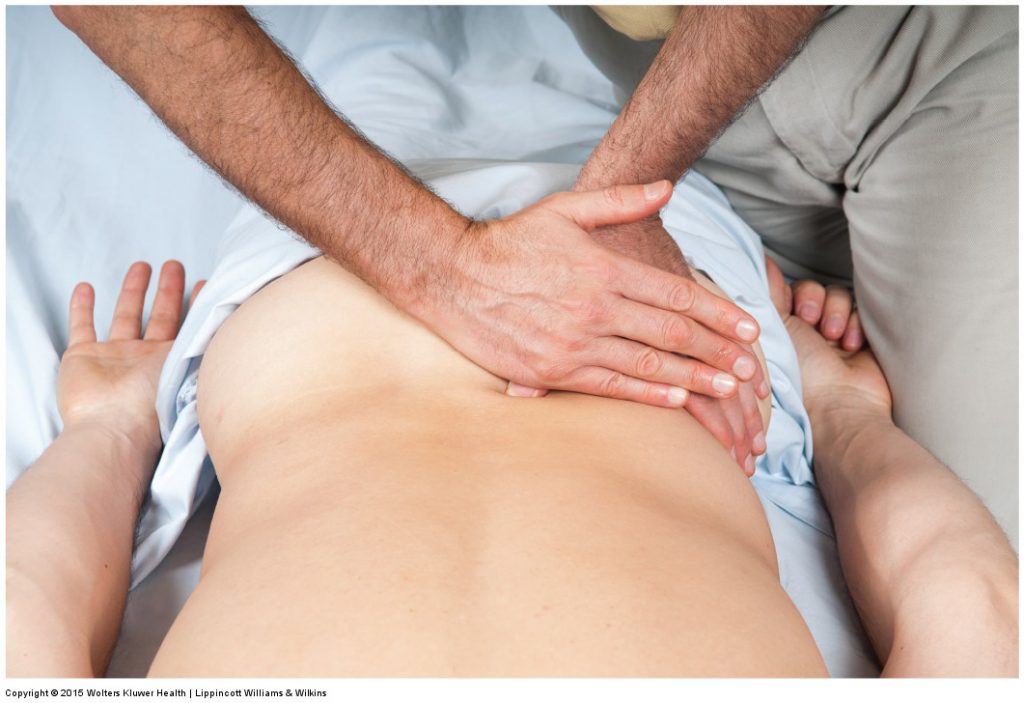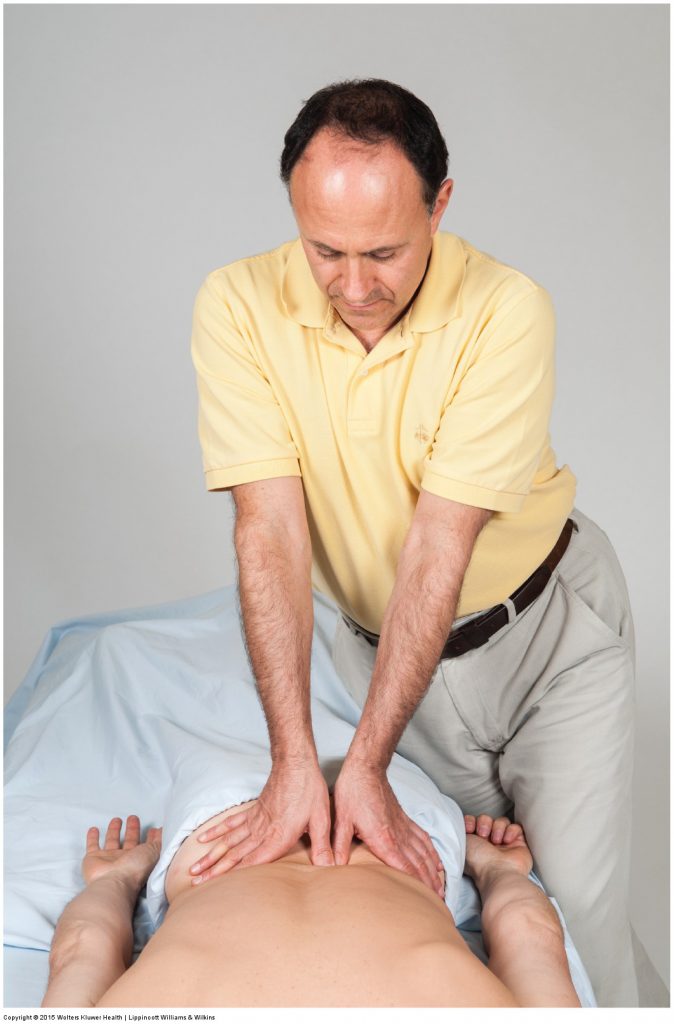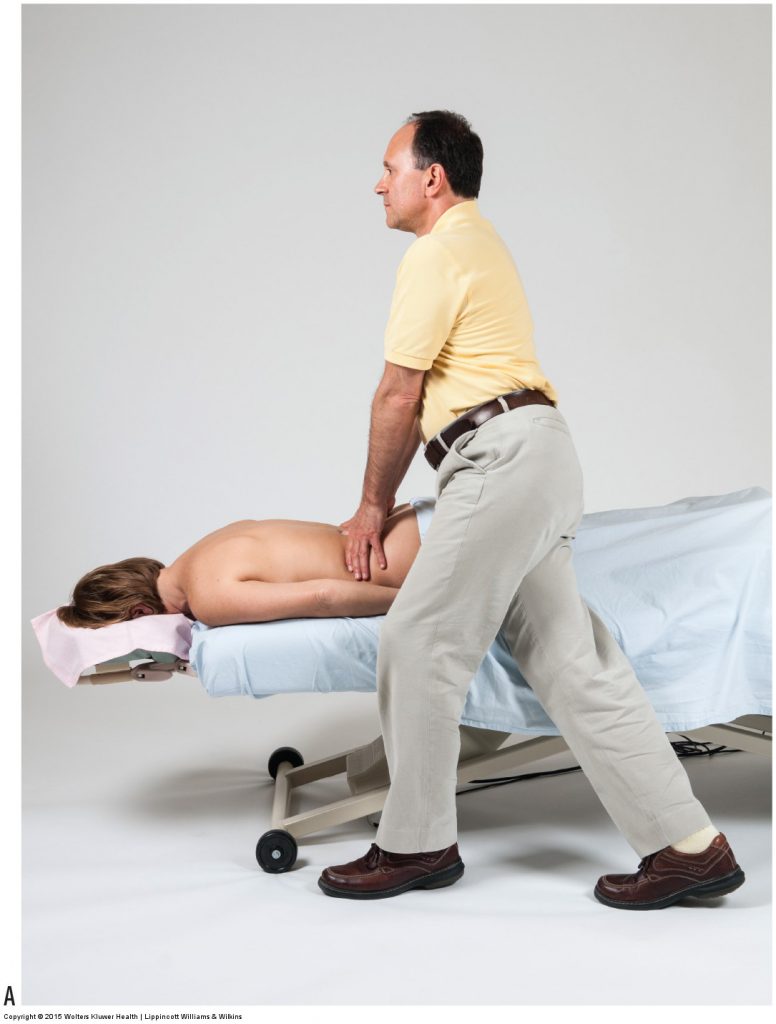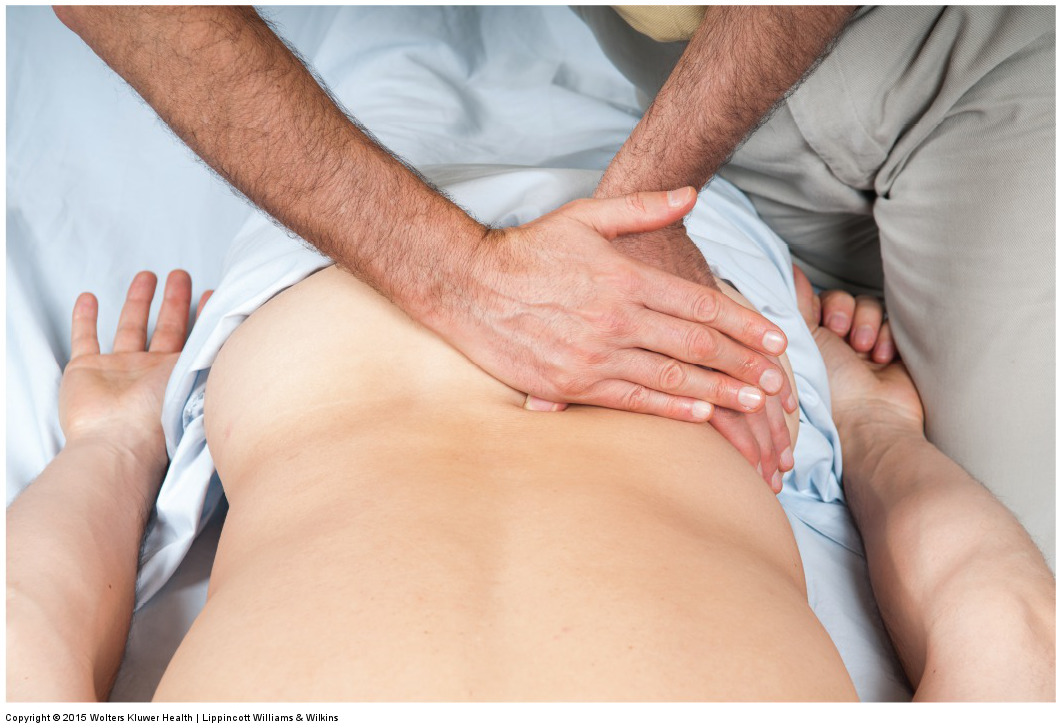This is the 1st in a series of 13 articles on Deep Pressure Massage Technique for the Low Back
Introduction

Permission Joseph E. Muscolino. Manual Therapy for the Low Back and Pelvis – A Clinical Orthopedic Approach (2013).
Soft tissue manipulation technique is a type of manual therapy that involves the introduction of force (pressure) by physically pressing into the soft tissues of the client’s body, usually the muscular and fascial tissues. The purposes of introducing pressure to physically work on the client’s tissues are many. They include producing changes in local fluid circulation, affecting neural proprioceptive feedback loops, and physically breaking patterns of fascial adhesions. The pressure that is applied can range from very light to very deep. Not everyone wants or needs to have deep pressure/deep tissue work performed; certainly, there are times when light work is preferable. However, when deep tissue work is desired or needed, it is important for you to be able to generate this deep pressure with the least amount of effort and physical stress to your body. In essence, this blog post article is about learning how to employ proper body mechanics so that you work smart instead of working hard. The body mechanics that are demonstrated in this article can be applied to all manual therapy strokes and techniques.
Mechanism
Because biomechanical principles follow the basic laws of physics, efficient biomechanics for performing deep tissue work techniques for the musculature of the low back and pelvis are identical to the biomechanical principles and guidelines for doing deep tissue work for any part of the body. Creating pressure is a matter of generating force into the client’s tissues. Force can be generated in two ways: externally or internally. The external generation of force comes from the force of gravity by using your body weight. The internal generation of force comes from the contraction of your muscles.

Permission Joseph E. Muscolino. Manual Therapy for the Low Back and Pelvis – A Clinical Orthopedic Approach (2013).
Externally, the force of gravity acts on the mass of your body to create body weight. You can take advantage of your body weight to generate pressure into the client’s tissues by simply dropping down and leaning into the client. Pressure derived this way is effectively free because it takes no effort on your part. For this reason, it should be used whenever possible. Because your core is the largest, most massive part of your body, you need to position it over the client and behind your contact whenever possible.
After you have generated as much force as possible via gravity and body weight, any additional force that you generate must come internally from the contraction of your muscles. This requires effort on your part, so it can be tiring. To minimize fatigue and wear and tear on your body, it is important to always use the largest muscles possible. This is especially important when it comes to deep pressure work. These larger muscles primarily are located proximally in the body. Larger muscles of the lower extremity can also be used.
Strokes and Techniques
This series of blog post articles is not about recommending any one massage stroke (e.g., compression or effleurage) or proprietary technique over another. Every stroke and every technique has merit. Similarly, no one stroke or technique is the magic bullet. If it were, everyone would be doing that stroke or technique, and no others would exist. Learning to be a clinical orthopedic manual therapist involves learning how to choose which strokes to use for which client based on the needs of the client who is lying on the table at that point in time. Strictly adhering to cookbook techniques is not recommended. The thrust of this series of articles is to employ critical thinking based on a fundamental understanding of the anatomy, physiology, and kinesiology of the body as well as an assessment and understanding of the pathomechanics of the client’s condition. Once that is accomplished, the goal is to then effectively and appropriately apply our hands-on treatment techniques techniques.
Terms: Deep Pressure versus Deep Tissue
For the most part, these articles uses the terms deep pressure and deep tissue work synonymously, but a distinction can be made. Deep tissue work implies that deeper tissues are the target structures being worked. Deep pressure does not; it can be employed for deeper or superficial tissues. However, because deep tissues usually require deeper pressure to reach them, these terms somewhat interchangeable.

Permission Joseph E. Muscolino. Manual Therapy for the Low Back and Pelvis – A Clinical Orthopedic Approach (2013).
Client Communication
The best measure of the appropriateness of the depth of your pressure should always be the response of the client’s tissues to the pressure that you are employing. You should be able to feel this with the finger pads or other treatment contact. In this regard, massage is a two-way street: You are not only exerting pressure into the client, you are also constantly monitoring the response of your client to the pressure. It is also extremely valuable to verbally check in with your client about the depth of the pressure when doing the massage. Even if you feel confident about the depth of pressure given the response from the client’s tissues, it is important to communicate directly with the client in a way that shows that you are aware of his or her desires and needs. This can help the client feel at ease and relax, which is especially important when doing deeper work.
How is the Pressure?
When asking the client about the pressure, you should not simply ask, “How is the pressure?” This question places your client in the position of having to criticize your massage, which many clients may not feel comfortable doing. As a result, the response is often “Fine,” whether it is or not.
Would you like more pressure or less pressure?
A better way to phrase the question is, “Would you like more pressure or less pressure?” Now you are specifically inviting the client to ask for a change in what you are doing, and the client has to go out of the way to say that it is fine as is. This phrasing is more likely to elicit an honest and accurate response and to create a massage that the client enjoys and from which the client benefits.
Icing to Increase Depth of Pressure
You never want deep tissue work to be painful and cause the client to tighten in response. However, there are times when the client’s musculature is very tender, not allowing you to work sufficiently deep to affect the desired change and improvement. In these cases, it can be helpful to ice an area to numb it so that you can work deeper than you otherwise would have been able to, without causing pain to the client. Sometimes, it also can be beneficial to ice after deep tissue work to decrease the likelihood of post-treatment pain and/or swelling.
This is the 1st of 13 articles on Deep Pressure Massage for the Low Back.
The thirteen articles are:
- Introduction to Deep Pressure Massage to the Low Back
- Deep Pressure Massage to the Low Back – Choosing the Right Table
- Deep Pressure Massage to the Low Back – Overview
- Deep Pressure Massage to the Low Back – Client and Therapist Positioning
- Deep Pressure Massage to the Low Back – Positioning the Feet
- Deep Pressure Massage to the Low Back – Choosing the Treatment Contact
- Deep Pressure Massage to the Low Back – Support Your Treatment Contact
- Deep Pressure Massage to the Low Back – Use Stacked Joints
- Deep Pressure Massage to the Low Back – Apply Pressure Perpendicularly
- Deep Pressure Massage to the Low Back – Use Body Weight
- Deep Pressure Massage to the Low Back – Tissue Tension Barrier
- Deep Pressure Massage to the Low Back – Deep Strokes
- Deep Pressure Massage to the Low Back – Forward Head Posture
(Click here for the blog post article: Introduction to Deep Pressure Technique for the Neck.)


